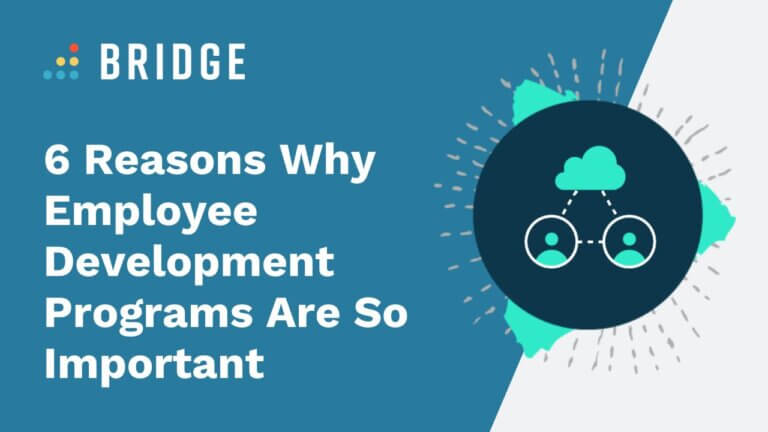Employee development isn’t new, but it’s hard to do well. It’s also important work. Helping people fulfill their potential in the workplace—whether that’s as an employee negotiating their position in the business, or as a manager improving as a coach and supervisor—has enormous benefits for the organizations that get things right. In this article, we take a closer look at employee development, consider why it’s so important, and discuss how you can create a development program that works for everyone.
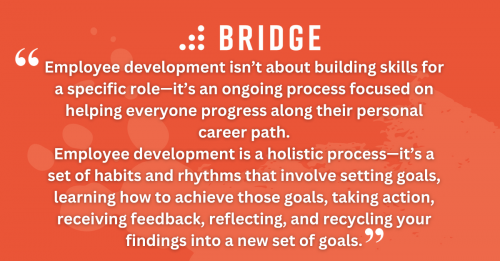
What Is Employee Development?
In broad terms, the talent problem faced by every organization operating today is the difficulty of attracting top talent, and then once that talent is onboard, of retaining them and finding the place within the businesses where they’ll fulfill their full potential. Candidates are looking for organizations that will challenge them in positive ways. They’re also looking for organizations that will help them find and fulfill their purpose.
The good news is that there’s a single approach that helps to address multiple aspects of this talent issue as a whole. That approach is employee development, a process where employees undertake professional training to improve skills, grow knowledge, and continue to lay essential groundwork for a successful career. Employee development isn’t about building skills for a specific role—it’s an ongoing process focused on helping everyone progress along their personal career path.
The bad news is that, with the way that learning, performance, and talent management are typically structured in many organizations, actually executing on this single approach can be challenging. Employee development is a holistic process—it’s a set of habits and rhythms that involve setting goals, learning how to achieve those goals, taking action, receiving feedback, reflecting, and recycling your findings into a new set of goals.
Employee development includes learning and many aspects that organizations have traditionally put under performance and talent management. However, it requires not only the combination of those disciplines but the transfer of power to your employees—you must create space for the process and allow employees to take charge of their own development.
These notions are not new, but they’re really hard to do. Aligning people to a common goal and helping them do their best in service of those goals is a struggle as old as humankind itself. Ultimately, it’s about nurturing habit.
THOUGHTS ON TALENT FROM OUR BLOG | ‘Rethinking the 9 Box Talent Review’
6 Reasons Why Your Employee Development Programs Are So Important
Before we get further into the specifics of execution, it makes sense to review why an employee development project makes an enormous amount of sense. Here are six great reasons to get you started:
1) Without Growth, Your Best Employees Are Likely to Leave!
There are as many reasons for leaving a job as there are vacancies. Those reasons have always been a more complex matter than compensation alone, and organizations can’t always simply throw money directly at the problem in order to keep the best employees.
One survey featured in Forbes found that two out of three employees were “extremely” or “somewhat” likely to leave their employer within the next 12 months because of a lack of skills development, career advancement, and ways to transition to different jobs or career paths.
Though In recent years we’ve seen people’s attitudes, perspectives, and expectations change dramatically—with Gartner proposing that many specifically seek purpose in their work—it’s important for organizations to not lose sight of tried-and-tested areas of the employee experience that can be easily improved. Building an effective employee development program is one such area: if an employee has a realistic chance of seeing the career growth they desire by staying, that’s one huge plus to weigh against the inevitable inconveniences of going elsewhere.
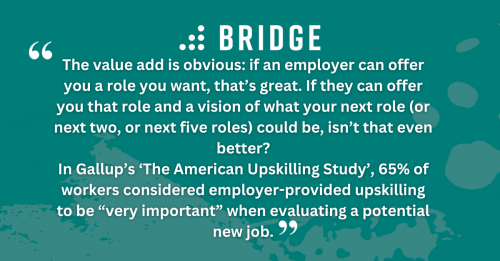
2) The Talent Market Expects Employee Development Opportunities
While many workers take the matter of career progression into their own hands by changing jobs, it still stands to reason that even they’ll be looking to land at an organization with a better attitude to skills and career advancement than the one they left. The value add is obvious: if an employer can offer you a role you want, that’s great. If they can offer you that role and a vision of what your next role (or next two, or next five roles) could be, isn’t that even better? After all, the concept of your lifetime of future job searches is never more alarming than when you’re already subjecting yourself to the stress and uncertainty of your current job search.
In Gallup’s ‘The American Upskilling Study’, 65% of workers considered employer-provided upskilling to be “very important” when evaluating a potential new job. Obviously, this shouldn’t just prompt organizations to have an employee development program—it should prompt them to have an employee development program that generates word of mouth, that any hiring manager could sincerely evangelize in an interview.
3) Employee Development Unlocks Your Future Leadership
One longitudinal study of CEO succession announcements published in the Harvard Law School Forum on Corporate Governance suggests that organizations favor insider CEO appointments. Insiders accounted for 62.3% of Russell 3000 CEO appointments in 2019, and on average these CEOs had been with the company for 11.4 years. There’s also a rising trend towards appointing non-executive directors to the CEO position: 20.8%, up from 16.4% in 2017.
The benefits of having people who know the business running the business are well documented. With insiders and even figures at non-executive levels desired for roles at the head of the business, it’s clearly important for organizations to design a pipeline to get them there.
Employee development programs can be an important part of your succession toolkit, both by nurturing leadership skills and allowing managers to identify candidates for such development (and employees to self-identify themselves as candidates). It’s also important for such development programs to span the entire business, providing continuity of support for anyone embarking on the full journey.
MORE ON LEADERSHIP | ‘Create Effective Leaders With These 7 Development Program Best Practices’
4) Employee Development Can Be Linked to Higher Engagement and Productivity
On the face of it, time spent on any form of training is time spent not working—and is therefore time spent being less productive. Of course, the reasonable counter-argument to this is that training broadly has a necessary role in creating productivity by preparing people to do their jobs more effectively. Without training, tasks would be done inefficiently or not at all.
Employee development programs are part of this bigger picture, though the link between development and productivity is tricky to draw. Tentatively we may point to Gallup’s claim that companies focusing on “strengths-based development” see a 9% to 15% increase in employee engagement, and an 8% to 18% improvement in performance. We say tentatively because growth into new roles and skillsets shouldn’t be exclusively about strengths, even if they’re likely to be an important guiding principle.
Regardless, these numbers do hint at a central truth: that development programs that center employee needs are naturally more engaging, and that engagement naturally correlates with higher performance. It’s intuitive that when you’re engaged by a role, when you can see a future for yourself at a company, you’re going to be more inclined to perform to the best of your ability.
5) Employee Development Is Linked to Profitability
Behind every benefit above are the potential savings your business could be making:
- Losing employees (and the investment you’ve made in those employees through their time at the organization) can cost you significantly. For example, the Harvard Business School has suggested mid-level manager hires take six months to reach a break-even point.
- Every hiring manager must balance efficient time to hire with finding and attracting the right replacement. While there’s value in taking your time, every day an unfilled role exists is a day that your organization is less productive
- While there are reasons to look outside your organization for executive hires, cost isn’t one of them. Internal executive hires usually cost less—studies suggest that external CEO hires, for instance, are paid 15% more than internal hires.
- Lost productivity through disengagement is a $7.8 trillion problem globally—and lack of development opportunities is a contributor.
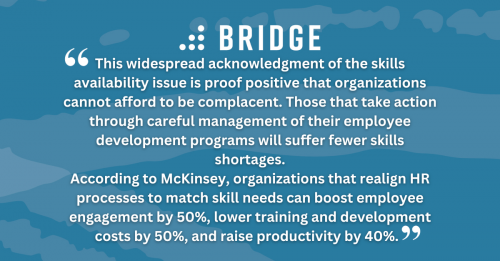
6) Without Development, Your Organization Will Fall Behind in Terms of Skills and Knowledge
Employee development programs are one of the main tools that you have in the fight against the world of work’s widening skills gaps. Skills gaps are somewhat inescapable—87% of companies say they have them, and only 6% claim that they don’t anticipate having any in the next ten years.
This widespread acknowledgment of the skills availability issue is proof positive that organizations cannot afford to be complacent. Those that take action through careful management of their employee development programs will suffer fewer skills shortages.
According to McKinsey, organizations that realign HR processes to match skill needs can boost employee engagement by 50%, lower training and development costs by 50%, and raise productivity by 40%.
TACKLING THE CHALLENGE OF SKILL SHIFT | ‘Predicting the In-Demand Skills for 2023 (And Beyond!)’
How to Create a Development Plan
As we’ve established, one of the big challenges in creating an Employee Development Plan is identifying a program that makes sense for a specific individual. While it’s potentially valuable to map out every possible job that exists at the company against skills and the learning that goes with each skill, it’s just as important to concentrate on supporting your managers as training coaches, and to be aware of your employee’s specific needs.
One simple but often neglected measure is to establish points in your process where employees have the opportunity to state intent. The platforms you use may support you in scheduling these check-ins. Bridge, for example, features a specific development plan feature. After doing the Bridge Career Drivers exercise, employees can reflect on what motivates them, and with those motivations as a prompt, they’re asked to think about:
- Future roles they may be interested in
- Specific skills they would be interested in growing
- Areas of focus for the next stage of personal development
This isn’t just a fun but ultimately isolated thought experiment: it’s important to tie these reflections back to the tasks, goals, and learning of the wider review process. If an employee wants to develop their skills in accountability, what are the goals, courses, and opportunities within the business that will facilitate that? This method provides a more organic way of tailoring your development plans—ideas for next steps are led by a conversation between the manager and their employees, and informed by the resources and possibilities available to them.
A good employee development plan requires a sense of purpose, and successful learning and development professionals find purpose in their focus on people.
3 Ways to Start Offering Employee Development Today
With the fundamentals in mind (and among them, the importance of having software capable of tying the experience together), it’s time to take action.
1) Choose a Platform That Brings Learning and Performance Together
Platforms like Bridge are specifically designed to bring learning and performance together, and it’s essential that the concept of the developmental cycle exists within the structure and philosophy of the platform. Bridge covers off the “Learning” element of the cycle by virtue of the fact it’s an LMS. Via Bridge Performance, it also covers taking action, task management, goal setting, and feedback with an expanded feature list. For example:
- Learners can demonstrate real-world actions taken via Bridge’s checkpoints feature
- Performance conversations are specifically developmental in nature, supported by one-on-one tools that facilitate coaching via peers and direct reports
- Feedback tools are integrated into the platform, allowing learners to easily request responses from around the organization in a variety of formats
- Learners are asked to reflect on their next steps and, separately, to set goals for each period
Having tools like these in a single place helps organizations steer away from the traditionally siloed nature of learning and performance work.
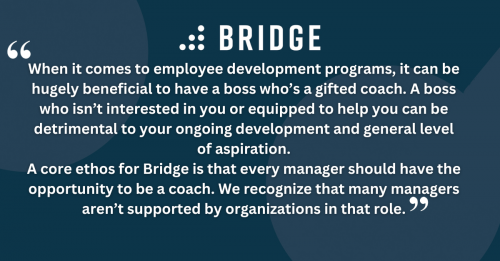
2) Choose a Platform That Empowers Your Managers
The old adage “people don’t leave companies, they leave managers” may shirk a lot of our responsibility onto our people, but there’s always been a kernel of truth in it—the relationships employees have with managers are among the most important they have in their lives. When it comes to employee development programs, it can be hugely beneficial to have a boss who’s a gifted coach. A boss who isn’t interested in you or equipped to help you can be detrimental to your ongoing development and general level of aspiration.
A core ethos for Bridge is that every manager should have the opportunity to be a coach. We recognize that many managers aren’t supported by organizations in that role. Sometimes the resources even exist in the organization, but they’re siloed off for high-potential programs or executive support—they do not provide resources collectively to their whole managerial pool.
Bridge provides support in two main ways:
- Bridge’s tools offer an assisted coaching experience. It recommends one-on-one questions that steer managers towards a development-minded conversation. The Bridge Career Drivers exercise offers a good preview of Bridge’s ethos in this area.
- Because learning is part of Bridge, it delivers all managerial coaching support within the same environment that managers are taking action—advice on how to have a good performance conversation or optimal 1:1 can be delivered in the same tool that those performance conversations and 1:1s are conducted.
GET AHEAD OF THE PLATFORM AFFORDABILITY CONVERSATION | ‘How to Create an L&D Budget You Can Defend to Your CFO’
3) Choose a Platform That Helps You Help Your People
A development-focused culture isn’t a new concept, but successful developmental conversations ultimately require organizations to form habits in their employees. It’s hard to create the rhythm initially, and many organizations may feel that their people aren’t yet ready to have the necessary conversations.
That’s where the software comes in—it provides visibility into who’s having one- on-ones and making L&D a habit, and these datapoints can then be correlated to team performance and prompt you to reach out to managers who may be struggling.
Ready to Build a Next-Level Employee Development Program?
Bridge gives organizations the power to create employee experiences that matter through its learning and performance management platform. In one unified experience, develop people-first managers, identify skills gaps, align team communication, and measure employee engagement. The Bridge platform is built on three principles: connection, alignment, and growth. This people-centric approach caters to the entire employee development experience.
Contact us today to see how you can empower skill and career growth, align goals across teams and organizations, and help your people realize their potential.
Read our Customer Story: Revolutionizing Employee Development and Performance to Achieve a 97% Staff Retention Rate
